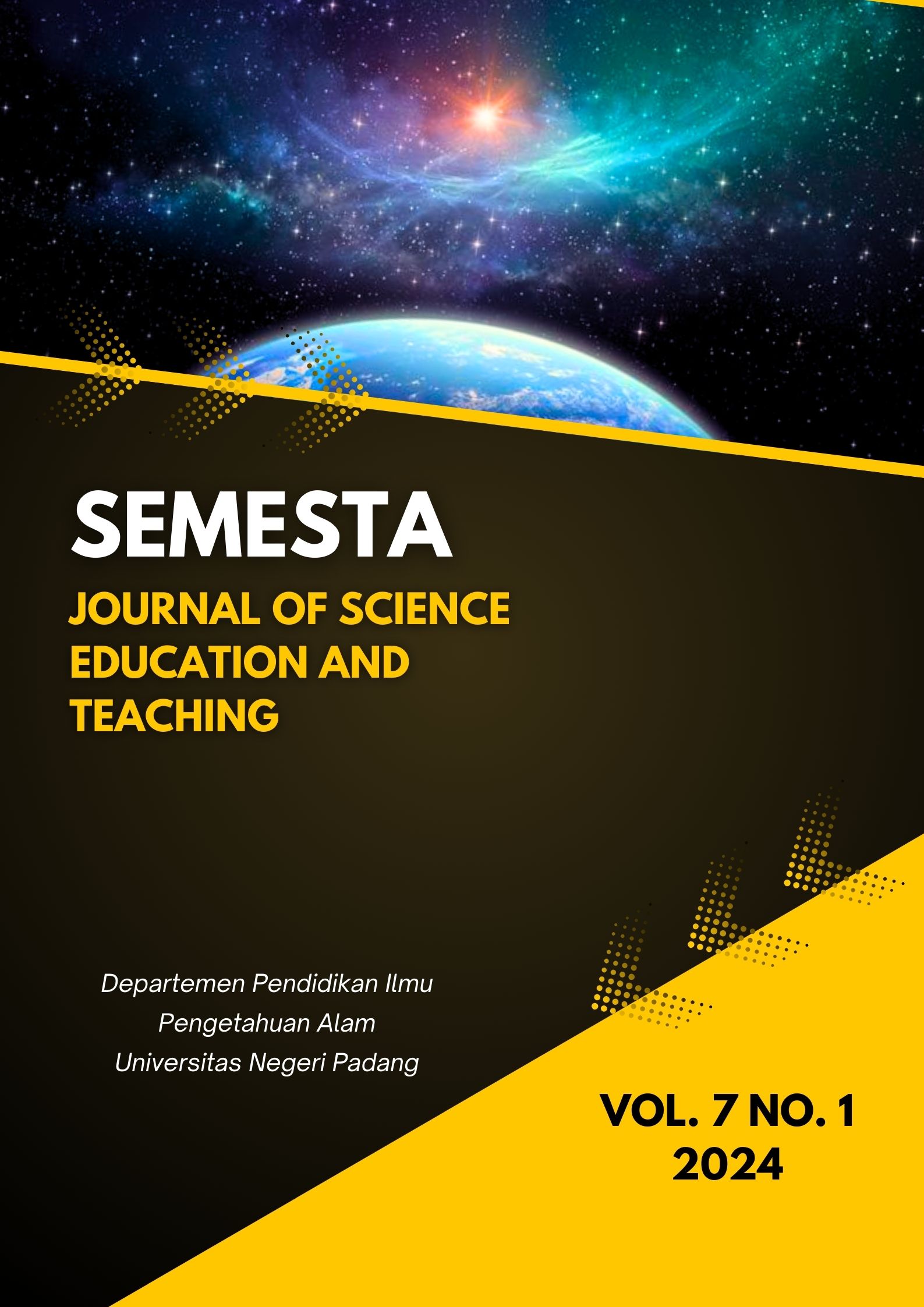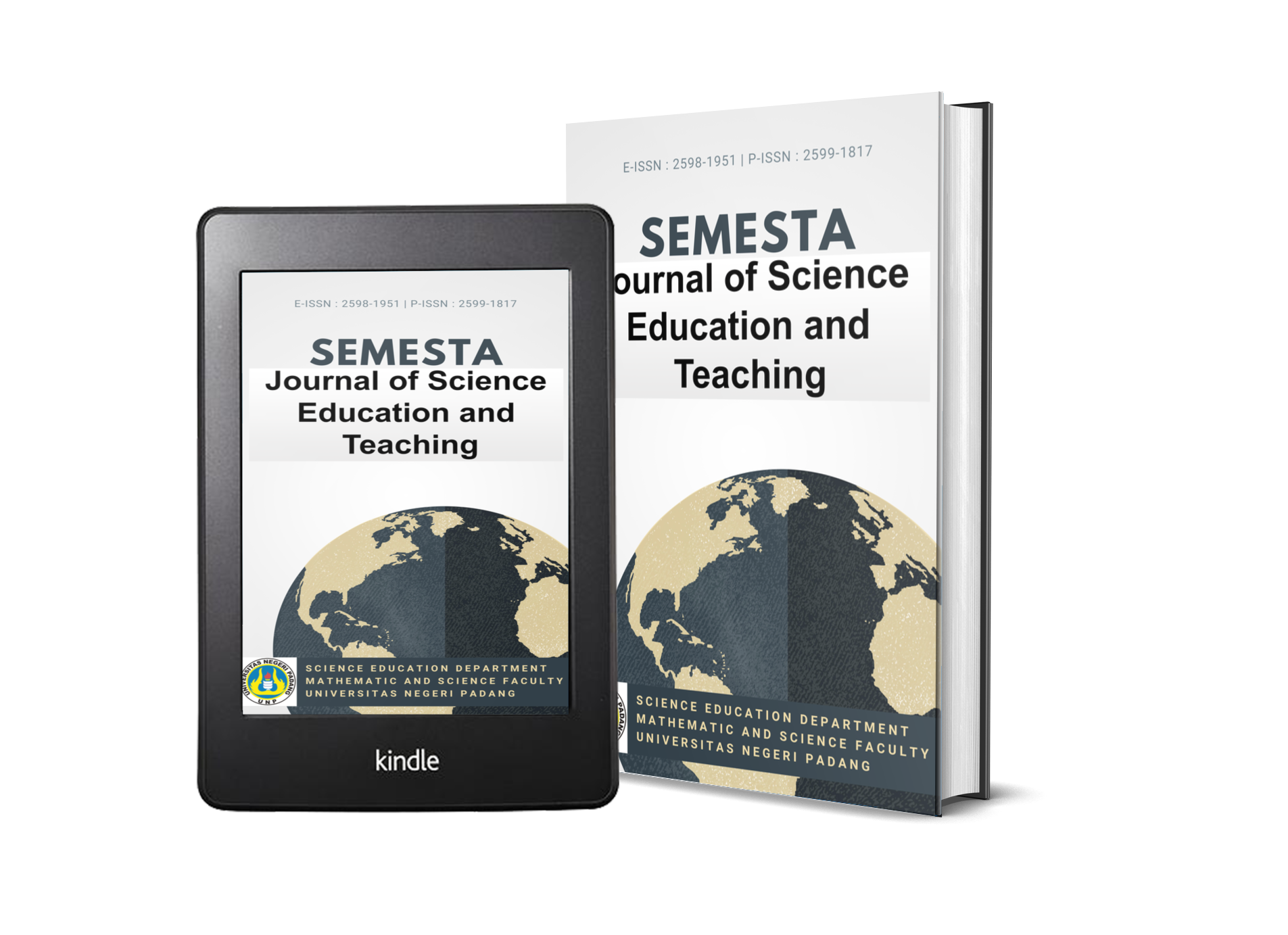THE EFFECT OF READING TO LEARN (R2L) MODEL ON SCIENCTIFIC LITERACY OF LIVING THINGS CLASSIFICATION LEARNING MATERIALS
DOI:
https://doi.org/10.24036/semesta/vol7-iss1/276Keywords:
Reading to learn, science literacy competency, science learningAbstract
This study aims to determine the effect of R2L model on scienctific literacy competence of students on the classification of Living Things learning material. The type of this research is a quasi experiment with nonequivalent control group design. This research was conducted in the 7th grade of SMPN 7 Payakumbuh, West Sumatra. The sampling was taken by purposive sampling technique to get 32 students of class VII.I as experimental group and 23 students of class VII.II as control group. The instrument used is a test of science literacy questions as many as 16 questions with 3 forms of questions. The results showed that the use of the R2L model increase the science literacy competence of students. The important syntax in supporting the improvement of students' scientific literacy competence is at the detailed reading and note-making stages. This stage allows students to read the reading text attentively and find important words in the text.
References
Arif, K., Rusma, O. R., & Alam Sad, T. M. (2023). The Influence of the R2L Learning Model on the Material of the Human Digestive System on Students’ Scientific Literacy. Jurnal Eksakta Pendidikan (Jep), 7(1), 94–104. https://doi.org/10.24036/jep/vol7-iss1/750
Arif, K., Rusma, O. R., Putri, A. M., & Azzahra, F. (2023). Effectiveness of the Reading to Learn (R2L) Model on Scientific Literacy Skills on Static Electricity Topic. Jurnal Penelitian Pendidikan IPA, 9(8), 6425–6431. https://doi.org/10.29303/jppipa.v9i8.3140
Fitria, Y.-, Alfa, D. S., Irsyad, M., Anwar, M., Adisva, Q. N. F., & Abdullah, H. (2022). Student Literacy Competence in Science Learning in Junior High Schools with the Reading to Learn Model. AL-ISHLAH: Jurnal Pendidikan, 14(2), 1607–1616. https://doi.org/10.35445/alishlah.v14i2.1321
Hasibuan, A. T., & Prastowo, A. (2019). Konsep Pendidikan Abad 21: Kepemimpinan Dan Pengembangan Sumber Daya Manusia Sd/Mi. MAGISTRA: Media Pengembangan Ilmu Pendidikan Dasar Dan Keislaman, 10(1), 26–50. https://doi.org/10.31942/mgs.v10i1.2714
Kemendikbud. (2023). Latar Belakang Kurikulum Merdeka. Pusat Informasi Guru. https://pusatinformasi.guru.kemdikbud.go.id/hc/en-us/articles/6824331505561-Latar-Belakang-Kurikulum-Merdeka
Kemendikbudristek. (n.d.). Kenali Kurikulum Merdeka, Tingkatkan Kualitas Pembelajaran. Kurikulum.Kemdikbud.Go.Id. https://kurikulum.kemdikbud.go.id/
Muttaqiin, A., Ananda, A. S. D., Aulia, P., Razi, P., Yusefarina, Y., & Yanuarsi, L. (2022). Profile of Students’ Character in the Reading to Learn (R2L) Model in Improving Scientific Literacy Skills. AL-ISHLAH: Jurnal Pendidikan, 14(4), 5431–5442. https://doi.org/10.35445/alishlah.v14i4.1503
OECD. (2017). How does PISA for Development measure scientific literacy? PISA for Development Brief 10, I(February 2014), 1–2. https://www.oecd.org/pisa/pisa-for-development/10-How-PISA-D-measures-science-literacy.pdf
OECD. (2019). PISA 2018 Results (Volume I): What Students Know And Can Do: Vol. I. OECD. https://doi.org/10.1787/5f07c754-en
Oktavia, R., & Aulia, P. (2023). Reading to Learn Models: A Strategy to Improve Student Science Literacy About Addictive, Additive, and Psychotropic Substances. IJIS Edu : Indonesian Journal of Integrated Science Education, 5(1), 1. https://doi.org/10.29300/ijisedu.v5i1.9376
Rose, D. (2020). Designing pedagogic registers: Reading to Learn Indigenous literacy View project Reading to Learn View project. July. https://www.researchgate.net/publication/334684457
Shum, M. S. kee, Tai, C. P., & Shi, D. (2018). Using ‘Reading to Learn’ (R2L) pedagogy to teach discussion genre to non-Chinese-speaking students in Hong Kong. International Journal of Bilingual Education and Bilingualism, 21(2), 237–247. https://doi.org/10.1080/13670050.2016.1159653
Sugiyono. (2008). Metode Penelitian Kuantitatif, Kualititatif dan R&D. Alfabeta.
Suryani, A. I., W, J. A., & Setiadi, D. (2017). Pengaruh Model Pembelajaran 5E Terintegrasi Pendekatan Saintifik Terhadap Kemampuan Literasi Sains Siswa SMPN 1 Kuripan Tahun Ajaran 2016/2017. Jurnal Pijar Mipa, 3(8), 85–102. https://doi.org/https://doi.org/10.29303/jpm.v12i1.339
Wulandari, A. T., & Jahro, I. S. (2023). Pengaruh Metode Reading To Learn dan Rangkuman Terhadap Hots-Literacy Sains Siswa Pada Materi Laju Reaksi. Pediaqu: Jurnal Pendidikan Sosial Dan Humaniora, 2(1). https://publisherqu.com/index.php/pediaqu/article/view/133

Downloads
Published
How to Cite
Issue
Section
License
Copyright (c) 2024 Elmesa Putri, Rani Oktavia, Khairil Arif, Arief Muttaqiin

This work is licensed under a Creative Commons Attribution 4.0 International License.





